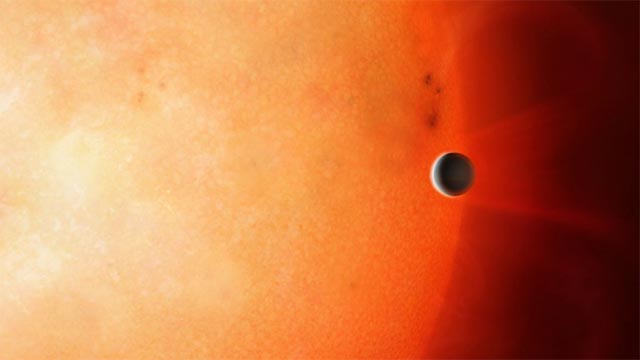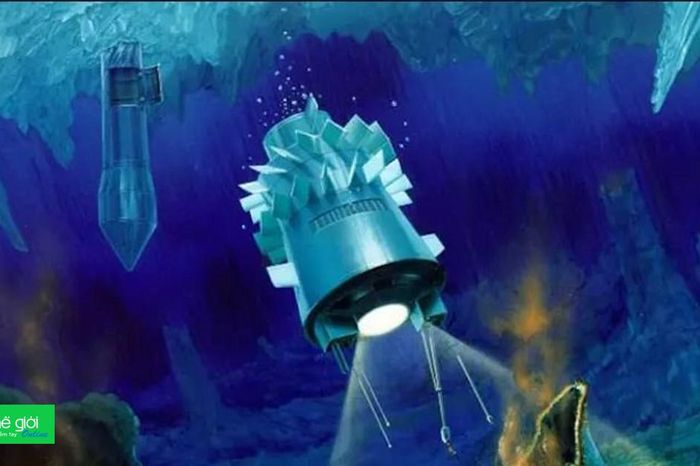Hot Jupiter is being torn apart by its host star
Located 1,000 light-years from Earth, NGTS-10b is a satellite of orange dwarfs 1060 light-years from Earth, also known as hot Jupiters. It possesses the shortest orbital period ever discovered for the same type of planet. Astronomers can now locate exoplanets using a method known as a 'transit method', in which people will measure the brightness of distant stars and rely on this parameter to looking for periodic luminance levels, which help identify a planet traveling through the space between its host star and the Earth.
'In theory, planets with short orbital periods (less than 24 hours) are most easily detected due to their large size and high-speed travel. However, such planets are extremely rare, 'said Dr. James McCormac from the Department of Physics at the University of Warwick in a statement.
Unlike the Earth that rotates on its own axis, NGTS-10b is locked, which means that one side of it is always directed toward the host star. Makes half of the planet's surface have temperatures above 1,000 degrees Celsius.

Astronomers have raised questions about how the planet lies so close to such a star, and the most reasonable assumption is that NGTS-10b was formed elsewhere and 'migrated'. to the current location. The common outcome of these planets is that they will eventually be "absorbed" or broken by its host star. The second scenario is probably the case with NGTS-10b because the gas planet is so close to its host star that scientists can see its orbital decay over time.
It is predicted that NGTS-10b is about 10 billion years old, and in the next decade, the time to complete its rotation will be 7 seconds shorter, gradually moving in a spiral before being 'ripped apart' by the star after 38 million years.
You should read it
- Detects the hottest outer planet in the universe, with temperatures up to 4,327 ° C
- Found the second planet of Proxima Centauri, the star closest to the sun
- Discovering the planet has an orbit of 4.5 hours, where people can live 150,000 years
- Strange black planet 'swallowed' 94% of light
- New discovery of life on planet GJ 1132b, 'Super Earth' is 39 light-years away
- Discover a new dwarf planet about the size of a Pluto in the Solar System
- The distance from Earth to Jupiter - what is the largest planet of the solar system?
- How big can the stars in the universe be?
May be interested
- Vsmart Star 3: Snapdragon 215, dual camera, 3500mAh battery, priced at 1.79 million
 vinsmart has just launched its new smartphone called vsmart star 3, an upgraded version of vsmart star with many color versions, dual cameras, priced at 1.79 million dong.
vinsmart has just launched its new smartphone called vsmart star 3, an upgraded version of vsmart star with many color versions, dual cameras, priced at 1.79 million dong. - Admire the rare brilliant light show on Jupiter
 on earth, we occasionally witness stunning auroras caused by solar activity – the most famous being the northern lights.
on earth, we occasionally witness stunning auroras caused by solar activity – the most famous being the northern lights. - The distance from Earth to Jupiter - what is the largest planet of the solar system?
 do you know the distance from earth to jupiter - what is the largest planet of the solar system? let's tipsmake.com find out!
do you know the distance from earth to jupiter - what is the largest planet of the solar system? let's tipsmake.com find out! - Stunning photos of the largest moon in the Solar System
 on june 7, nasa's juno spacecraft captured stunning images of jupiter and its icy moon ganymede - the largest moon in the system. the sun, as it flies closer to it than any other spacecraft since 2000.
on june 7, nasa's juno spacecraft captured stunning images of jupiter and its icy moon ganymede - the largest moon in the system. the sun, as it flies closer to it than any other spacecraft since 2000. - Does the North Star ever move across the sky?
 the north star is famous for being fixed in the northern sky. but it actually moves. here's what you need to know about the movement of the north star.
the north star is famous for being fixed in the northern sky. but it actually moves. here's what you need to know about the movement of the north star. - Close up of the star is said to be a giant structure of aliens
 the tabby star, also known as kic 8462852, is located 1,400 light-years from earth, unusually turned off and then bright, making scientists think of the possibility that it is a structure that aliens have built. to harness the star's energy.
the tabby star, also known as kic 8462852, is located 1,400 light-years from earth, unusually turned off and then bright, making scientists think of the possibility that it is a structure that aliens have built. to harness the star's energy. - How to fix Task Host window error preventing Windows shutdown
 the issue might say task host is stopping background tasks , meaning you have to wait for it to complete or close it manually.
the issue might say task host is stopping background tasks , meaning you have to wait for it to complete or close it manually. - Protect computer network with Bastion host (fortress server) in just 3 steps
 do you have computers on your local network that need to be accessed from outside? using the bastion host - as the gatekeeper - the gatekeeper for your network can be a good solution.
do you have computers on your local network that need to be accessed from outside? using the bastion host - as the gatekeeper - the gatekeeper for your network can be a good solution. - Fix Service Host Local System status using multiple CPUs in Windows 10
 in task manager, you can see that service host: local system is taking up most of disk, cpu and memory usage. today's article will show you how to overcome the situation that service host local system is using a lot of cpu.
in task manager, you can see that service host: local system is taking up most of disk, cpu and memory usage. today's article will show you how to overcome the situation that service host local system is using a lot of cpu. - Analyze the chances of living beings existing on Jupiter's moons
 to clarify the question of whether there are creatures on europa, nasa plans to launch europa clipper in october - the largest spacecraft they have ever developed for planetary missions.
to clarify the question of whether there are creatures on europa, nasa plans to launch europa clipper in october - the largest spacecraft they have ever developed for planetary missions.










 Jupiter's atmosphere has more water than we think
Jupiter's atmosphere has more water than we think Successfully launched the ultra-modern solar exploration spacecraft worth $ 672 million
Successfully launched the ultra-modern solar exploration spacecraft worth $ 672 million Found the second planet of Proxima Centauri, the star closest to the sun
Found the second planet of Proxima Centauri, the star closest to the sun NASA wants to make spacecraft parts right on low Earth orbit
NASA wants to make spacecraft parts right on low Earth orbit This is the most detailed photograph of the sun's surface that humans have ever taken
This is the most detailed photograph of the sun's surface that humans have ever taken Saturn's 'tiny' moon hides essentials for life
Saturn's 'tiny' moon hides essentials for life